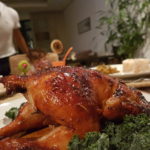I want to feed my baby good food, real food. We started to give her a taste of solids this summer at my mother’s summer-house in Egypt’s North Coast. My mom is incredibly resourceful in the kitchen, and with a dozen mouths to feed everything had to be made fresh daily. Much of our food came from her hometown, Nahtay, on the farms of the Nile Delta. Our relatives sent us fresh meats, eggs, fruits and vegetables from their own personal farms. With just a handful of additional ingredients we had a delicious, healthy meal of real food every day.
Now we are back home in Kuwait and she’s almost 8 months old! We now give her a little cup of food twice a day. I decided to follow the feeding guidelines set by the American Pediatric Association. They recommend feeding children a wide variety of flavors and textures, and note that “babies and toddlers are more likely to eat foods they see their peers and parents eating.” In other words, weaning a baby is a collective family effort to eat nutritious, healthy food.
But what is that exactly? In this day and age it seems like everything at the supermarket has some label that promises a healthy nutritious option. So, in my next grocery trip I read every ingredient list for every item I usually get. I was shocked at how many ingredients we were eating that I couldn’t identify. I would go for our usual condiments, yogurt, ice cream or cereal and get halfway through the ingredient list before I realized I had no idea what I was reading.
Four hours later, with a sleeping baby in a sling at my chest, I paid almost twice as much as I usually do and left with less groceries. Eating organic would cost us a fortune. More important, I gained a profound distrust for everything sold at the supermarket. I decided to make as much as I could at home, from ingredients that come from nature.
That night I set up a reading wish list on my Kindle and came across Real Food, Fake Food by Larry Olmsted. I started reading and came across this passage: “Unless you are leaving the supermarket via the ‘8 Items or Less’ express lane, something in your cart is likely fake.” Not mislabeled, or misleading but fake. He cites cases like Parmesan cheese sold by Kraft that contains about 8% wood chips. I have no interest in eating wood chips, much less feeding them to my baby.
Thus began my journey to the express lane at the grocery store. In one year’s time I hope to always be standing at the express line at the grocery store. I hope to be eating everything homemade, and if not we will go without.
It’s a huge undertaking, I realize. As a stay at home mom I am able to focus all my time and attention on creating the best environment for my baby and our family. Yet, once you get in the habit of eating clean food, made completely from ingredients you can trust, it’s hard to go back.
So, I’ll try to make this as simple as possible for you. I’ll do the research, but you have to try out some of these recipes and methods. I’ll talk to experts, read as much as I can online and off and share it with you in podcasts, blogs and videos. We’ll look at what kind of equipment and time you need to make each ingredient, and try recipes so you can really up your kitchen game with homemade basics.
At the end of the week you may decide that you actually kind of like the store-bought ricotta a bit better, or that churning your own butter is just way to much work. I ultimately hope we will encourage each other to be more mindful about the food we eat.



